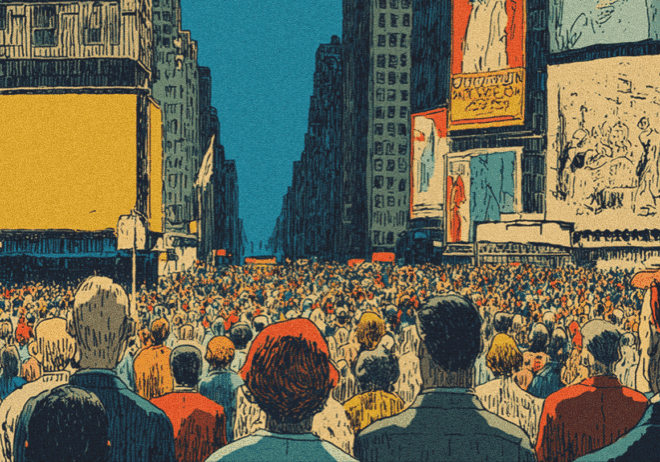
Gen Z in Marketing Firms is Disappearing from Workspace
Gen Z in marketing has always been an enigma for corporations. While we always discuss reports and stats on Gen Z consumers, today, we are focusing on their contribution to marketing workspaces.
A shocking report from Live Data Technologies revealed that staff-level roles at America’s ad and marketing firms have dropped more than 10 percent for this young generation.
It is significant to note that Gen Zers are becoming one of the biggest consumer bases, yet ad agencies are denying them space inside their creative departments.
What could be more concerning in today’s world, where AI and ML are becoming the market language, while at the same time, the young generation (age group of 20-24) is denied jobs in creative roles?
We will dive deep into Gen Zers’ becoming of the ‘ unwanted’ phase, how it affects the current market situation, and what solutions could be found.
Young demography in chaos
Marketing firms are losing talent. According to the U.S. Bureau of Labor Statistics 2024 stats, only 46 employees out of 709 between the ages of 20 and 24 held advertising, PR, and marketing jobs.


The Federal Reserve Bank of New York also notes that unemployment among college grads aged 22 to 27 is now higher than the national average.
The decade-long tradition of the younger generation having stronger job prospects and a higher percentage of position holding suddenly turned grey and grimaced.
Entry-level jobs in marketing firms that offer job experience to young hires are disappearing. Mid-level managerial positions and leadership positions have enough hiring going on.
So, the question here is what compels these marketing firms not to hire young talent? The answers vary. However, the prima facie causations are:
AI eats the entry-level ladder
Traditionally, fresh hires cut their teeth on grunt work — data entry, report pulling, campaign monitoring, drafting dozens of ad copy variations. Guess what? AI now does that faster, cheaper, and without calling in sick.
The very tasks that used to justify a junior hire are now automated. So instead of onboarding a 22-year-old to run analytics dashboards or generate client decks, firms lean on AI tools and keep the payroll lean. Under the label of ‘efficiency,’ this structural shift wipes out the apprenticeship layer that marketing careers relied on.
Gen Z wants money, not “exposure”
Marketing firms aren’t exactly Wall Street. Starting salaries are notoriously underwhelming, often masked with the lure of “creativity” or “portfolio building.” But Gen Z grew up during recessions, pandemics, and crushing student debt — they’re no longer romanticizing long hours for prestige.
If the paycheck doesn’t justify the workload (and many entry-level marketing roles pay like an afterthought), they’ll skip the industry entirely for fields that cough up better starting salaries. For firms, that means fewer willing takers from the talent pool and less incentive to create roles for them.
Work is just ‘work’ (and firms hate it)
Older generations were trained to “stick it out” at one firm to climb the ladder. Gen Z doesn’t buy into that. They treat jobs like apps — download, test, delete if buggy. Why?
They prioritize mental health, flexibility, and career pivots over company loyalty. They’re quick to ditch roles that burn them out, and agency leadership tracks usually do burn people out.
From the firm’s side, why invest in training young hires when they’re likely gone in a year, especially when replacing them is a headache? From Gen Z’s side, why chain yourself to a firm’s hierarchy when LinkedIn recruiters are one DM away with a better gig?
Everyone must know these reasons, as everyone knows the naked truth. Shading human resources in the name of technology and productivity is merely another stockholder’s interest.
That is not going to result in a win-win situation for either of the parties. Ad agencies are leaving the cream of the crop outside. The aftermath situation will be:
- 1. The market will be full of AI slop.
Without young creatives cutting their teeth, agencies will lean heavier on AI to churn out campaigns. The result? A homogenous sea of “AI-polished” content that looks fine but feels soulless — the same tired formats, recycled captions, and algorithm-driven ideas. Basically, the market risks drowning in beige mediocrity.
- 2. Marketing is a human job for human consumers.
You can’t algorithm your way into empathy. Consumers want relatability, nuance, and cultural wit — things machines don’t grasp in real time. Strip the human layer out of ad-making, and you’ll get campaigns that check boxes but miss the heartbeat. Marketing stops being about people and starts sounding like an overlong chatbot ad.
- 3. Insights die without humans at the desk.
Data alone is useless. Numbers only turn into insights when a human asks “why” behind the “what.” With fewer juniors growing into strategists, that interpretive layer shrinks. Firms might collect endless dashboards of consumer behavior, but without human brains digging into them, the insights will stay surface-level, stale, or flat-out wrong.
- 4. No Gen Z = no Gen Z resonance.
Gen Z knows how their peers talk, joke, shop, and boycott. Without their voices inside the agency, the creative misses the cultural beats that connect. You can’t fake slang or vibes — brands that try usually get roasted. Leaving Gen Z talent outside means agencies lose the inside track to the very consumers dominating the subsequent decades of buying power.
The young generation and the old generation in marketing are left behind
In one of our articles, we explored ageism in marketing. Over 55% of those surveyed were aged 40-54, showing that ageism often begins mid-career. The impact becomes even steeper for professionals over 50 at the highest risk.
We recommended a hiring process where the industry could use creativity in its recruitment and retention strategies. Rolling out mentorship programs or flexible career paths for seniors, but still have the desire to contribute?
In the same way, the younger generation should not be left behind. Their need in the creative department is a necessity for brands more than a charity to these talents.
Make “talent renewal” a KPI
If agencies measure every click and CPM, why not track how well they replenish their workforce? A metric that ties leadership bonuses to bringing in and retaining young + senior talent would force firms to take this seriously.
Rethink leadership tracks
Not everyone wants the “VP of Whatever” role. Create alternative career ladders where people can grow deep into creative, tech, or strategy lanes without being forced into people management. This keeps older and younger talent invested without forcing them into roles they don’t want.
Flexible, project-based entry points
Instead of insisting on rigid full-time roles, create project-based or rotational gigs for young hires. This lowers the risk for agencies while giving new talent the chance to prove themselves. The same goes for older professionals — flexible contracts keep them in the game without burning them out.
Cut to the chase
Gen Z in marketing firms is at its lowest for many reasons. However, the impact on the market and the talent pool will be irreversible. Ad agencies must identify solutions before the gap widens beyond repair.

